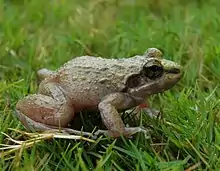Indirana leithii
Indirana leithii (Leith's leaping frog, Leith's frog, Boulenger's brown frog, Matheran leaping frog, or Matheran Indian frog) is a species of frog in the family Ranixalidae.[3] It is endemic to the northern Western Ghats of India. As currently defined, its range is restricted to the states of Maharashtra and southern Gujarat; earlier records elsewhere refer to other species.[3][4][5]
| Leith's leaping frog Indirana leithii | |
|---|---|
 | |
| Female Indirana leithii from Matheran | |
| Scientific classification | |
| Domain: | Eukaryota |
| Kingdom: | Animalia |
| Phylum: | Chordata |
| Class: | Amphibia |
| Order: | Anura |
| Family: | Ranixalidae |
| Genus: | Indirana |
| Species: | I. leithii |
| Binomial name | |
| Indirana leithii | |
 | |
| Synonyms[3] | |
| |
Etymology
The specific name leithii honours Andrew Henderson Leith, a physician who worked as Sanitary Commissioner in Bombay.[6]
Description
Adult males measure 19–29 mm (0.7–1.1 in) and adult females 24–36 mm (0.9–1.4 in) in snout–vent length.[4] The tympanum is two-thirds of the eye diameter; a strong supra-tympanic fold runs from the eye to the shoulder. The fingers and toes bear enlarged discs; the toes are two-thirds webbed. Dorsal skin is rough with number of folds. Colouration is brownish with many, closely set black spots. The limbs are cross-barred. The venter is white while the throat is finely mottled with brown.[7]
The following description is adopted from George Albert Boulenger's "Fauna of British India":[8]
Vomerine teeth in two oblique groups are set just behind the level of the choanae. A free, pointed papilla sits on the middle of the tongue. The head is moderate; the snout is obtuse, with obtuse canthus rostralis and concave loreal region; the nostril is nearer to the end of the snout than to the eye; the interorbital space is a little narrower than the upper eyelid; the tympanum is distinct, two thirds the diameter of the eye. The fingers are moderate, the first extending not quite as for as second; the toes are two-thirds webbed, the web reaching the disks of the third and fifth toes; tips of fingers and toes dilated into small but well-developed disks; subarticular tubercles moderate; a single, small, oval inner metatarsal tubercle; no tarsal fold is present. The tibio-tarsal articulation reaches halfway between the eye and the end of the snout. The skin of the back has small scattered longitudinal warts; a strong fold runs from the eye to the shoulder. It is brown above, with small dark spots; limbs with dark transverse bands; lower parts white, throat mottled with brown. From snout to vent 1.25 inches.
Habitat
Indirana leithii is a terrestrial species associated with leaf-litter of moist, tropical, semi-evergreen forest, including degraded forests.[1] It occurs at elevations between 139 and 1,329 m (456 and 4,360 ft) above sea level.[4] Breeding takes place on wet rocks. The tadpoles can be found on moist surfaces next to streams.[1]
This species was included as "vulnerable" in the IUCN Red List of Threatened Species in 2004. It is primarily threatened by the conversion of forested land to intensive agricultural use, but also by harvesting of wood for subsistence, road construction, and tourism are threats.[1]
References
- S.D. Biju, Sushil Dutta, Anand Padhye, Robert Inger (2004). "Indirana leithii". IUCN Red List of Threatened Species. 2004: e.T58311A11763222. doi:10.2305/IUCN.UK.2004.RLTS.T58311A11763222.en. Retrieved 20 November 2021.
{{cite journal}}: CS1 maint: multiple names: authors list (link) - Boulenger, G.A. (1888). "Descriptions of two new Indian species of Rana". Annals and Magazine of Natural History. 6. 2: 506–508. doi:10.1080/00222938809487521.
- Frost, Darrel R. (2019). "Indirana leithii (Boulenger, 1888)". Amphibian Species of the World: an Online Reference. Version 6.0. American Museum of Natural History. Retrieved 18 August 2019.
- Modak, N.; Padhye, A. & Dahanukar, N. (2014). "Delimiting the distribution range of Indirana leithii (Boulenger, 1888) (Anura: Ranixalidae), an endemic threatened anuran of the Western Ghats, based on molecular and morphological analysis". Zootaxa (3796): 62–80. doi:10.11646/zootaxa.3796.1.3. PMID 24870665.
- Dahanukar, Neelesh; Modak, Nikhil; Krutha, Keerthi; Nameer, P. O.; Padhye, Anand D. & Molur, Sanjay (2016). "Leaping frogs (Anura: Ranixalidae) of the Western Ghats of India: An integrated taxonomic review". Journal of Threatened Taxa. 8 (10): 9221–9288. doi:10.11609/jott.2532.8.10.9221-9288.
- Beolens, Bo; Watkins, Michael & Grayson, Michael (2013). The Eponym Dictionary of Amphibians. Pelagic Publishing. p. 122. ISBN 978-1-907807-42-8.
- Venkataraman, K.; Chattopadhyay, A. & Subramanian, K.A., eds. (2013). Endemic Animals of India (Vertebrates). Kolkata: Zoological Survey of India. pp. 235+26 plates. [Indirana leithii: p. 102]
- Boulenger, G. A. (1890). Fauna of British India, including Ceylon and Burma. Vol. Reptilia and Batrachia. London: Taylor and Francis. 570 pp. [Rana leithii: p. 453]
